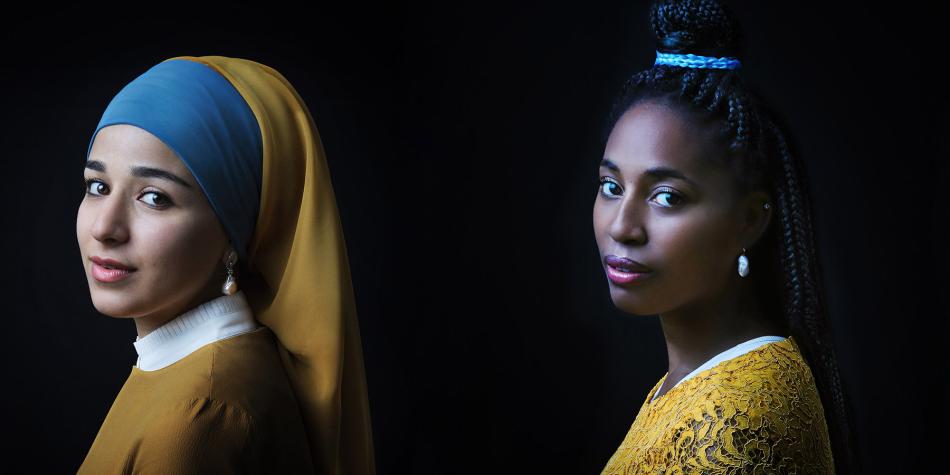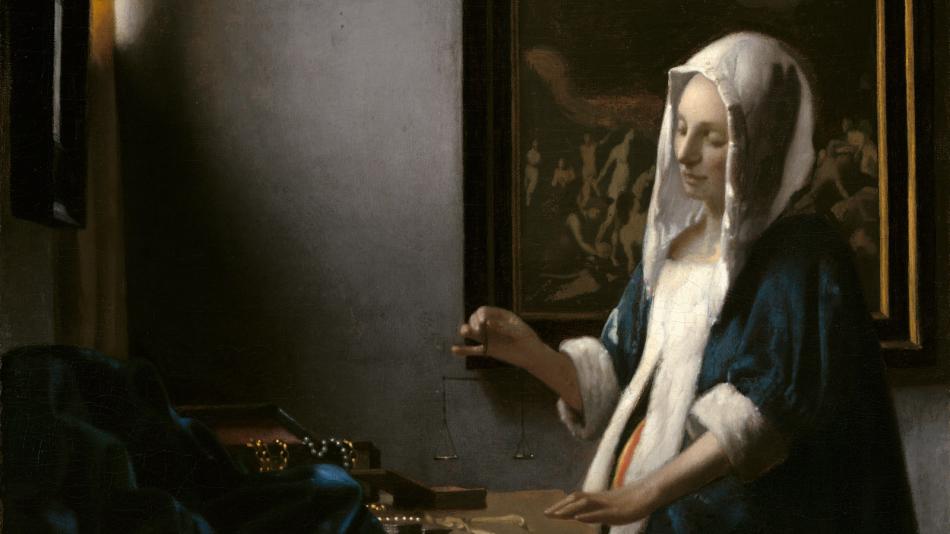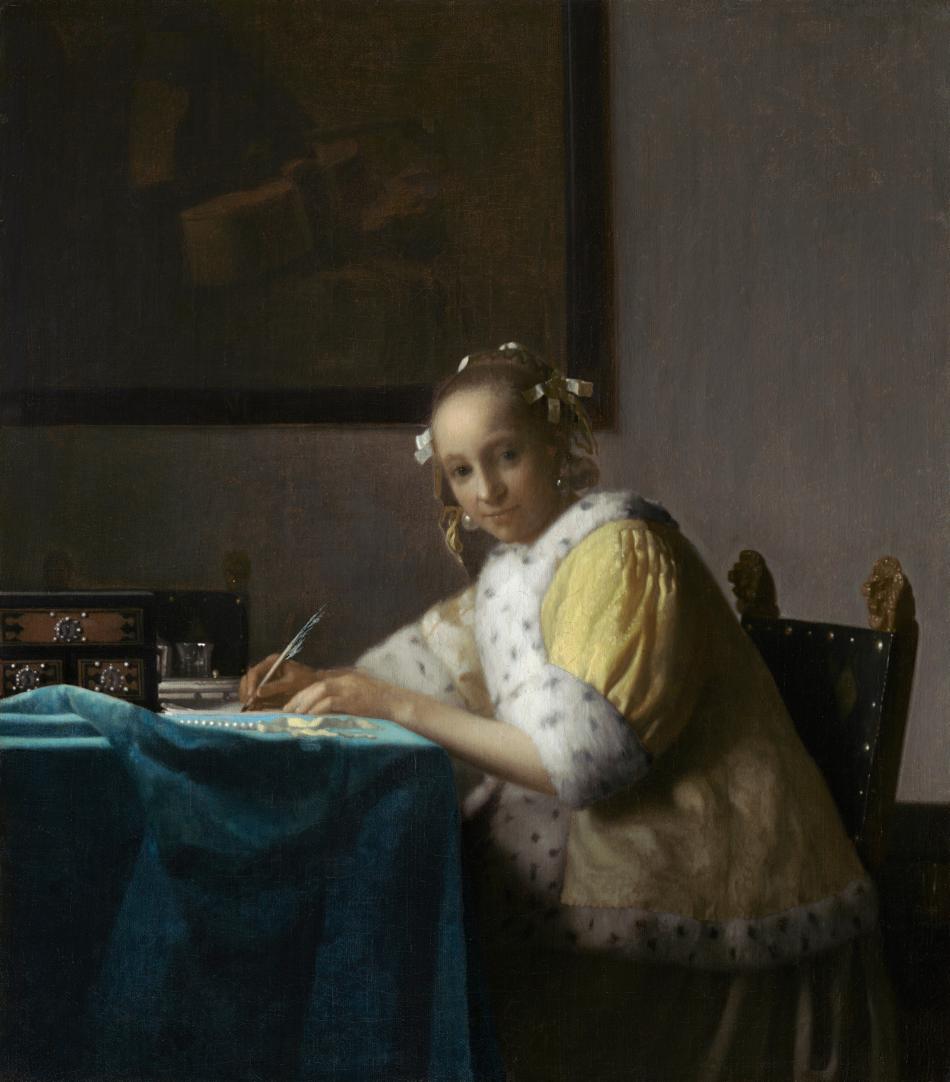A Lady Writing
c. 1665
Johannes Vermeer
Artist, Dutch, 1632 - 1675
Above all, Johannes Vermeer was a painter of light. In this exquisite painting, diffused light softly illuminates the tabletop, the woman’s face, and her rich lemon-yellow morning jacket. Accents on the pearls decorating her jewelry box, her earrings, and her satin hair ribbons further enliven the image. The woman’s open gaze engages the viewer, which suggests that the painting may be a portrait instead of a generalized portrayal of a young woman at her writing table.
Johannes Vermeer became a master in the Saint Luke’s Guild of Delft on December 29, 1653. At that time he specialized in history painting, and his first works were large-scale mythological and religious paintings. Shortly thereafter he began to paint the genre scenes, landscapes, and allegories for which he has become so renowned. Even though Vermeer's subject matter changed in the mid-1650s, he continued to imbue his later works with the quiet, intimate moods he had preferred in his early history paintings. His oeuvre is small: only 35 paintings are currently attributed to the master.

West Building Main Floor, Gallery 50-A
Artwork overview
-
Medium
oil on canvas
-
Credit Line
-
Dimensions
overall: 45 x 39.9 cm (17 11/16 x 15 11/16 in.)
framed: 68.3 x 62.2 x 7 cm (26 7/8 x 24 1/2 x 2 3/4 in.) -
Accession Number
1962.10.1
More About this Artwork

Interactive Article: Reconsidering Vermeer’s Perfectionism
What can we learn about 17th-century Dutch artist Johannes Vermeer by examining the pigments in his paintings?

Article: Vermeer’s Fiercest Fans
A profound appreciation for the paintings of Dutch artist Johannes Vermeer unites these three people—and many others.

Article: Who Is Vermeer?
Johannes Vermeer's life might be missing many details, but what we do know helps us understand this extraordinary Dutch painter.

Video: Vermeer: In the Light of Delft
Johannes Vermeer's classic painting A Lady Writing inspired this evocative film.

Video: Explore Johannes Vermeer's "Woman Writing a Letter" with Meryl Streep
Understand Johannes Vermeer's A Lady Writing and the secrets of his technique in a new way with the help of X-ray analysis, infrared reflectography, and computer technology.
Artwork history & notes
Provenance
Possibly Pieter Claesz van Ruijven [1624-1674], Delft; possibly by inheritance to his wife, Maria de Knuijt [d. 1681]; possibly by inheritance to her daughter, Magdalena van Ruijven [1655-1682], Delft; possibly by inheritance to her husband, Jacobus Abrahamsz. Dissius [1653-1695], Delft;[1] (his sale, Amsterdam, 16 May 1696, no. 35).[2] J. van Buren, The Hague; (his sale, Bernardus Scheurleer, The Hague, 7-12 November 1808, 6th day [12 Nov.], no. 22 of the paintings). Dr. Cornelis Jan Luchtmans [1777-1860], Rotterdam; (his sale, by Mierop, Muys van Leen, and Lamme, Rotterdam, 20 and 22 April 1816, 1st day, no. 90); J. Kamermans, Rotterdam; (his sale, by A. Lamme, Rotterdam, 3 October 1825, no. 70); Lelie.[3] Hendrik Reydon; (his sale, by J. de Vries, A. Brondgeest, E.M. Engelberts, and C.F. Roos, Amsterdam, 5-6 April 1827, no. 26). François-Xavier, comte de Robiano [1778-1836], Brussels; (his estate sale, Hotel du Défunt, Brussels, 1 May 1837 and days following, no. 436); purchased by Héris for François-Xavier's son. Ludovic, comte de Robiano [1807-1887], Brussels; by inheritance to Ludovic's heirs, possibly his daughter and only child, Jeanne [1835-1900] and her husband, Gustave, baron de Senzeilles de Soumagne [1824-1906], until 1906;[4] (J. & A. LeRoy, Brussels); purchased 1907 by J. Pierpont Morgan [1837-1913], New York; by inheritance to his son, J. P. Morgan, Jr. [1867-1943], New York; consigned 1935-1939 to, and purchased 1940 by (M. Knoedler & Co., New York); sold 1940 to Sir Harry Oakes [1874-1943], Nassau, Bahamas; by gift or inheritance to his wife, Lady Eunice Myrtle McIntyre Oakes [c. 1894-1981], Nassau, Bahamas; consigned 1946 to (M. Knoedler & Co., New York);[5] sold 1946 to Horace Havemeyer [1886-1956], New York; by inheritance to his sons, Harry Waldron Havemeyer [b. 1929], New York, and Horace Havemeyer, Jr. [1914-1990], New York;[6] gift 1962 to NGA.
[1] The 1683 inventory of goods accruing to Jacob Dissius after the death of his wife Magdalena van Ruyven lists twenty paintings by Vermeer. For the complete transactions between her husband Jacob Dissius and his father Abraham Dissius following her death, see John Michael Montias, Vermeer and His Milieu: A Web of Social History, Princeton, 1989: 246-257, 359-361, docs. 417, 420.
[2] For this sale see Michael Montias, Vermeer and His Milieu: A Web of Social History, Princeton, 1989: 363-364, doc. 439.
[3] This name is recorded in an annotated copy of the sale catalogue in the NGA Library.
[4] This is suggested by the Getty Provenance Index© Databases, Public Collections, record 17464.
[5] The Knoedler’s consignment numbers were CA 1503 (from Morgan) and CA 2758 (from Lady Oakes), per the Getty Provenance Index© Databases, Public Collections, record 17464.
[6] Harry W. Havemeyer (correspondence 12 August 2010) indicated that Vermeer’s painting hung over the fireplace in the library of their residence at 720 Park Avenue, but emphasized that the fireplace, therefore, was never used. He wrote that his father probably had first admired the painting at the Hudson-Fulton exhibition in 1909, and was pleased to be able to acquire it from Knoedler’s when it was offered to him in 1946. Harry and Horace Havemeyer decided to donate the painting to the National Gallery of Art because of their father’s admiration for the Gallery and its director John Walker.
Associated Names
Exhibition History
1873
Exposition de tableaux et dessins d'anciens maîtres, La société néerlandaise de bienfaisance à Bruxelles, Brussels, 1873, no. 264.
1908
Loan to display with the permanent collection, The Metropolitan Museum of Art, New York, 1908 and 1909-1913.
1909
The Hudson-Fulton Celebration, The Metropolitan Museum of Art, New York, 1909, no. 136.
1935
Vermeer, Oorsprong en Invloed, Fabritius, de Hooch, de Witte, Museum Boymans-van-Bauningen, Rotterdam, 1935, no. 86a.
1939
Masterpieces of Art. European Paintings and Sculpture from 1300-1800, New York World's Fair, 1939, no. 399. repro.
1940
Loan Exhibition of Allied Art for Allied Aid for the Benefit of the Red Cross War Relief Fund, M. Knoedler & Co., New York, 1940, no. 6.
1941
Loan Exhibition in Honor of Royal Cortissoz and His 50 Years of Criticism in the New York Herald Tribune, M. Knoedler & Co., New York, 1941, no. 71.
1942
Paintings by the Great Dutch Masters of the Seventeenth Century, Duveen Galleries, New York, 1942, no. 68, repro.; Art Institute of Chicago, no. 42, repro.
1943
An Exhibition of Paintings by Living Masters of the Past, Baltimore Museum of Art; The North Carolina State Art Society Gallery, Raleigh, 1943, unnumbered catalogue, repro.
1946
Loan Exhibition of 24 Masterpieces, M. Knoedler & Co., New York, 1946, no. 15, repro.
1976
Chefs-d'oeuvre de Musées des États-Unis de Giorgione à Picasso, Musée Marmottan, Paris, 1976, no. 18, repro.
Zapadnoevropeiskaia i Amerikanskaia zhivopis is muzeev ssha [West European and American Painting from the Museums of USA], State Hermitage Museum, Leningrad; State Pushkin Museum, Moscow; State Museums, Kiev and Minsk, 1976, unnumbered catalogue.
1987
Space in European Art: Council of Europe Exhibition in Japan, National Museum of Western Art, Tokyo, 1987, no. 86.
1989
Masterpieces of Western European Painting of the XVIth-XXth Centuries from the Museums of the European Countries and USA, State Hermitage Museum, Leningrad, 1989, no. 14, repro.
1990
Great Dutch Paintings from America, Mauritshuis, The Hague; The Fine Arts Museums of San Francisco, M. H. de Young Memorial Museum, 1990-1991, no. 67, color repro., as A Girl Writing a Letter.
1993
Leselust: Niederländische Malerei von Rembrandt bis Vermeer, Schirn Kunsthalle Frankfurt, Germany, 1993-1994, no. 85, repro.
1995
Johannes Vermeer, National Gallery of Art, Washington, D.C.; Royal Cabinet of Paintings Mauritshuis, The Hague, 1995-1996, no. 13, repro.
1999
Johannes Vermeer: The Art of Painting, National Gallery of Art, Washington, D.C., 1999-2000, not in brochure.
Masterpieces from the National Gallery of Art, Washington, Kyoto Municipal Museum of Art; Tokyo Metropolitan Art Museum, 1999, no. 83, repro.
2001
Art and Home: Dutch Interiors in the Age of Rembrandt, The Newark Museum; Denver Art Museum, 2001-2002, no. 108, fig. 108 (shown only in Denver).
2003
Love Letters: Dutch Genre Paintings in the Age of Vermeer, National Gallery of Ireland, Dublin; Bruce Museum of Arts and Science, Greenwich, Connecticut, 2003-2004, no. 38, fig. 55, repro. 181 (shown only in Dublin).
2004
Senses and Sins: Dutch Painters of Daily Life in the Seventeenth Century, Museum Boijmans Van Beuningen, Rotterdam; Städelsches Kunstinstitut und Städtische Galerie, Frankfurt, 2004-2005, no. 69, repro.
2008
Loan for display with permanent collection, Norton Simon Museum, Pasadena, 2008-2009.
2011
Human Connections in the Age of Vermeer, Kyoto Municipal Museum of Art; The Miyagi Museum of Art, Sendai; The Bunkamura Museum of Art, Tokyo, 2011-2012, no. 42, repro.
2015
Class Distinctions: Dutch Painting in the Age of Rembrandt and Vermeer, Museum of Fine Arts, Boston; The Nelson-Atkins Museum of Art, Kansas City, 2015-2016, no. 31, repro.
2016
Loan for display with permanent collection, Chrysler Museum of Art, Norfolk, 2016.
2017
Vermeer and the Masters of Genre Painting: Inspiration and Rivalry, Musée du Louvre, Paris; National Gallery of Ireland, Dublin; National Gallery of Art, Washington, 2017-2018, no. 2.3, repro.
2018
Making the Difference: Vermeer and Dutch Art, Ueno Royal Museum, Tokyo; Osaka City Museum, 2018-2019, no. 46.
2022
Vermeer's Secrets, National Gallery of Art, Washington, 2022 - 2023, no catalogue.
Bibliography
1825
Murray, Lady. Tour in Holland in the Year MDCCCXIX. London, n.d. (1825?): 29.
1866
Thoré, Théophile E. J. (William Bürger). "Van der Meer de Delft." Gazette des Beaux-Arts 21 (October–December 1866): 543, 564. no. 40.
1888
Havard, Henry. Van der Meer de Delft. Paris, 1888: 38, no. 43.
1907
Hofstede de Groot, Cornelis. A Catalogue Raisonné of the Works of the Most Eminent Dutch Painters of the Seventeenth Century. 8 vols. Translated by Edward G. Hawke. London, 1907-1927: 1(1907):598, no. 36.
Hofstede de Groot, Cornelis. Beschreibendes und kritisches Verzeichnis der Werke der hervorragendsten holländischen Maler des XVII. Jahrhunderts. 10 vols. Esslingen and Paris, 1907-1928: 1(1907):603, no. 36.
1908
"Recent Loans." Bulletin of the Metropolitan Museum of Art 3 (April 1908): 76.
1909
Valentiner, Wilhelm R. Catalogue of a collection of paintings by Dutch masters of the seventeenth century. The Hudson-Fulton Celebration 1. Exh. cat. Metropolitan Museum of Art. New York, 1909: xlii, 137, no. 136, repro., 157, 161.
Cortissoz, Royal. "Old Dutch Masters." Bulletin of the Metropolitan Museum of Art 4 (10 October 1909): 166.
Stephenson, B. P. "Great Dutch Artists." Bulletin of the Metropolitan Museum of Art 4, no. 10 (October 1909): 168, 172, repro.
1910
"Kleine Nachrichten." Der Cicerone 2 (1910): 109-110.
Friedländer, Max J. "Die Ausstellung holländischer Bilder im Metropolitan Museum zu New York 1909." Repertorium für Kunstwissenschaft 33 (1910): 95-99.
Breck, Joseph. "Hollandsche kunst op de Hudson-Fulton tentoonstelling te New York." Onze Kunst 17 (February 1910): 5-12, 41-47.
Valentiner, Wilhelm R. "Die Ausstellung holländischer Gemälde in New York." Monatshefte für Kunstwissenschaft 3 (1910): 11, 12, pl. 8, fig. 14.
Valentiner, Wilhelm R. Catalogue of a Loan Exhibition of Paintings by Old Dutch Masters Held at the Metropolitan Museum of Art in Connection with the Hudson-Fulton Celebration. New York, 1910: 26, repro. 456, 457, no. 136.
Cox, Kenyon. "Art in America, Dutch Paintings in the Hudson-Fulton Exhibition II." The Burlington Magazine 16, no. 82 (January 1910): 246.
Cox, Kenyon. "Art in America, Dutch Paintings in the Hudson-Fulton Exhibition III." The Burlington Magazine 16, no. 83 (February 1910): 303 pl. 3.
1911
Plietzsch, Eduard. Vermeer van Delft. Leipzig, 1911: 118, no. 31.
1913
Hale, Philip L. Jan Vermeer of Delft. Boston, 1913: 240, 250-252, 373, repro.
1921
Vanzype, Gustave. Jan Vermeer de Delft. Brussels and Paris, 1921: 17, 74, repro.
1924
Hausenstein, Wilhelm. "Vermeer van Delft." Das Bild Atlanten zur Kunst 10 (1924): 27, fig. 22.
1926
Chantavoine, Jean. Ver Meer de Delft. Les grands Artistes. Paris, 1926: 47, 59, 76, repro.
1935
Hannema, Dirk. Vermeer: Oorspong en invloed Fabritius, De Hooch, De Witte. Exh. cat. Museum Boymans, Rotterdam, 1935: plate 67a, no. 86a.
Hévésy, André de. "Review of 1935 exhibition “Vermeer, Oorsprong en invloed. Fabritius, De Hooch, De Witte,” Museum Boymans-van Beuningen, Rotterdam." Le Bulletin de l’art, ancien et moderne 68 (November 1935): 363-366, repro.
Overbeek, J. M. C. van. "Jan Vermeer en zijn Delftsche omgeving. Naar aanleiding van de tentoonstelling in het nieuwe Boymansmuseum." Elsevier’s Geïllustreerd Maandschrift 45 (1935): 231-238, repro. 53.
Bazin, Germain. "L’Exposition Vermeer à Rotterdam." L’Amour de l’art 16, no. 9 (1935): 335-336, repro.
Huyghe, René. "Vermeer et Proust". L’Amour de l’art 17 (1935): 8, 10, figs. 6 and 21.
1937
Bremmer, Henricus Petrus. "Vermeer." Beeldende Kunst 23 (March 1937): 86-87, no. 87, repro.
Hale, Philip Leslie. Vermeer. Edited by Frederick W. Coburn and Ralph T. Hale. Boston and New York, 1937: 101, no. 35, 118, 226, pl.14.
1939
McCall, George Henry. Masterpieces of art: Catalogue of European paintings and sculpture from 1300-1800. Edited by Wilhelm R. Valentiner. Exh. cat. New York World's Fair, New York, 1939: no. 399, repro.
Plietzsch, Eduard. Vermeer van Delft. Munich, 1939: 30, 61, no. 28, pl. 31.
Trivas, Numa S. "Oude kunst op de New Yorksche wereldtentoonstelling." Elsevier’s Geïllustreerd Maandschrift 49 (August 1939): 136-141.
Vries, Ary Bob de. Jan Vermeer van Delft. Bibliotheek der Nederlandsche Kunst. Amsterdam, 1939: 46-47, 88, no. 26, pl. 50.
1940
Comstock, Helen. "The Connoisseur in America. Loan Exhibition for War Relief." The Connoisseur 106 (October 1940): 112-114, repro.
Frankfurter, Alfred M. "Allied Art for Allied Aid. Important French, British, Dutch and Flemish Works in the Red Cross Benefit." Art News 39 (15 June 1940): 9, repro., 17.
Goldscheider, Ludwig. The Paintings of Jan Vermeer. Oxford and New York, 1940: 13, pl. 35.
M. Knoedler & Co. Loan Exhibition of Allied Art for Allied Aid for the Benefit of the Red Cross War Relief Fund. Exh. cat. M. Knoedler & Co., New York, 1940: no. 6.
1941
M. Knoedler & Co. Loan exhibition in honour of Royal Cortissoz and his 50 years of criticism in the New York Herald Tribune. Exh. cat. M. Knoedler & Co., New York, 1941: no. 17.
1942
Frankfurter, Alfred M. "Proving the Dutch Masters Great." Art News 41 (October 1942): 11, 35, repro.
McCall, George Henry. Paintings by the great Dutch masters of the seventeenth century: loan exhibition in aid of the Queen Wilhelmina Fund and the American Women's Voluntary Services. Exh. cat. Duveen Galleries, New York, 1942: 89, pl. 68.
Martin, Wilhelm. Rembrandt en zijn tijd: onze 17e eeuwsche schilderkunst in haren bloetijd en nabloei. Vol. 2 of De Hollandsche Schilderkunst in de Zeventiende Eeuw. 2nd ed. Amsterdam, 1942: 193, 196 fig. 99.
1943
Baltimore Museum of Art. An Exhibition of Paintings by Living Masters of the Past. Exh. cat. Baltimore Museum of Art; The North Carolina State Art Society Gallery, Raleigh. Baltimore, 1943: unnumbered catalogue, repro.
1944
Rigby, Douglas, and Elizabeth Rigby. Lock, Stock and Barrel: The Story of Collecting. Philadelphia, 1944: 13.
1945
Vries, Ary Bob de. Jan Vermeer van Delft. Basel, 1945: 58, 116, no. 26, pl. 51.
1946
Blum, André. Vermeer et Thoré-Burger. Geneva, 1946: 179, no. 40.
M. Knoedler & Co. Loan Exhibition of 24 Masterpieces. Exh. cat. M. Knoedler & Co., New York, 1946: no. 15, repro.
1948
Hultén, Karl Gunnar. "Zu Vermeers Atelierbild." _Konsthistorisk Tidskrift _ 17 (1948): 90-98, no. 35.
Vries, Ary Bob de. Jan Vermeer van Delft. Translated by Robert Allen. Revised ed. London and New York, 1948: 39-40, 88-89, pl. 19.
1949
Allen, Frederick Lewis. The Great Pierpont Morgan. New York, 1949: 109.
Thienen, Frithjof van. Jan Vermeer of Delft. Masters of Painting. New York, 1949: 23, no. 24, repro.
1950
Swillens, P. T. A. Johannes Vermeer: Painter of Delft, 1632–1675. Translated by C.M. Breuning-Williamson. Utrecht, 1950: 53, 67, 78, 82, 87, 89, 108, pl. 8.
1951
Boström, Keil. "Jan Vermeer van Delft en Cornelis van der Meulen." Oud Holland 66 (1951): 117-122, repro.
1952
Gowing, Lawrence. Vermeer. London, 1952: 134, no. xviii, fig. 42.
Malraux, André, ed. Vermeer de Delft. Paris, 1952: 65, no. xiii, repro.
1954
Bloch, Vitale. Tutta la Pittura di Vermeer di Delft. Milan, 1954: 35, pl. 53.
1958
Goldscheider, Ludwig. Jan Vermeer: The Paintings. London, 1958: 137-138, no. 20, pl. 50.
1961
Mirimonde, Albert P. de. "Les sujets musicaux chez Vermeer de Delft." Gazette des Beaux-Arts 57 (January 1961): 36 fig. 6, 40, 51 n. 27.
Reitlinger, Gerald. The Rise and Fall of Picture Prices 1760-1960. (Vol. 1 of The Economics of Taste). London, 1961: 483.
1963
Bloch, Vitale. All the Paintings of Jan Vermeer. Translated by Michael Kitson. The Complete Library of World Art 15. New York, 1963: 35, pl. 53.
1965
Summary Catalogue of European Paintings and Sculpture. National Gallery of Art, Washington, 1965: 135.
1966
Descargues, Pierre. Vermeer. Translated by James Emmons. Geneva, 1966: 65, repros. 130 and 134.
1967
Bianconi, Piero. The Complete Paintings of Vermeer. New York, 1967: 93, no. 28, repro.
Koningsberger, Hans. The World of Vermeer 1632-1675. New York, 1967: 154-155, repro.
1968
Frick Collection. The Frick Collection: An Illustrated Catalogue. 2 vols. Vol. 1, Paintings: American, British, Dutch, Flemish and German. New York, 1968: 1:298.
National Gallery of Art. European Paintings and Sculpture, Illustrations. Washington, 1968: 122, repro.
1969
Sutton, Peter C. "Pleasure for the Aesthete." Apollo 90 (September 1969): 230-239.
1973
Fahy, Everett, and Francis John Bagott Watson. The Wrightsman Collection. Vol. 5: Paintings, drawings, sculpture. New York, 1973: 316, repro.
Mistler, Jean. Vermeer. Collection Le Peintre et l’Homme. Paris, 1973: no. 22, color repro.
1974
Canfield, Cass. The Incredible Pierpont Morgan: Financier and Art Collector. New York, 1974: 107, 169, repro.
Grimme, Ernst Günther. Jan Vermeer van Delft. Cologne, 1974: 77, no. 27, fig. 18.
1975
Blankert, Albert. Johannes Vermeer van Delft, 1632-1675. Utrecht, 1975: 11, 36, 82-84, 109, 153-154, no. 20, pl. 20.
National Gallery of Art. European paintings: An Illustrated Summary Catalogue. Washington, 1975: 362-363, repro.
1976
Wright, Christopher. Vermeer. London, 1976: 12, 42, 44, 81, no. 16, repro.
Daulte, François. Chefs-d'oeuvre de musées des États-Unis: de Giorgione à Picasso. Exh. cat. Musée Marmottan, Paris, 1976: no. 18, color repro.
Bessonova, Marina A. Zapadnoevropeiskaia i Amerikanskaia zhivopis is muzeev ssha [West European and American painting from the Museums of USA]. Exh. cat. Hermitage Museum, St. Petersburg; Pushkin Museum, Moscow; State Museum Kiev; State Museum Minsk. Moscow, 1976: unpaginated and unnumbered.
1977
Menzel, Gerhard W. Vermeer. Leipzig, 1977: 68, fig. 65.
1977 Annual Report. National Gallery of Art. Washington, D.C., 1977: 47, repro.
Straaten, Evert van. Johannes Vermeer, 1632-1675. Een Delfts schilder en de cultuur van zijn tijd. The Hague, 1977: 48-49, fig. 60.
1978
King, Marian. Adventures in Art: National Gallery of Art, Washington, D.C. New York, 1978: 53, pl. 30.
Blankert, Albert. Vermeer of Delft: Complete Edition of the Paintings. Oxford, 1978: 25, 54, 56, 73, 164, no. 20, figs. 20-20a.
1981
Slatkes, Leonard J. Vermeer and His Contemporaries. New York, 1981: 70-71, repro.
Wheelock, Arthur K., Jr. Jan Vermeer. New York, 1981: 124-127, no. 31, color pls. 31, 32 (detail).
1982
Reitlinger, Gerald. The Economics of Taste: The Rise and Fall of Picture Prices, 1760–1960. 3 vols. Reprint. New York, 1982: 1:483.
1984
Walker, John. National Gallery of Art, Washington. Rev. ed. New York, 1984: 300, no. 399, color repro.
1985
National Gallery of Art. European Paintings: An Illustrated Catalogue. Washington, 1985: 421, repro.
1986
Aillaud, Gilles, Albert Blankert, and John Michael Montias. Vermeer. Paris, 1986: 11, 46, 52, 85, 132, 189-190, no. 20, pl. 22.
1987
Kokuritsu Seiyo Bijutsukan. Space in European art. Exh. cat. Keidanren Kaikan, Tokyo, 1987: 86.
1989
Montias, John Michael. Vermeer and His Milieu: A Web of Social History. Princeton, 1989: 191-192, 196, 256, 266, repro. 44.
Obnovlenskaia, N.G. Masterpieces of western European painting of the XVIth-XXth centuries from the museums of the European countries and USA. Exh. cat. State Hermitage Museum, Leningrad, 1989: no. 14, repro.
1990
Broos, Ben P. J., ed. Great Dutch Paintings from America. Exh. cat. Royal Picture Gallery Mauritshuis, The Hague; Fine Arts Museums of San Francisco. The Hague and Zwolle, 1990: 456-461, no. 67, color repro. 457.
1991
Nash, John. Vermeer. London, 1991: color repro. 34, 36-37.
Buijsen, Edwin. "Een terugblik op 'De kunst van het verzamelen'." In De Kunst van het Verzamelen. Cahier 2. Edited by Edwin Buijsen. The Hague, 1991: 7-12, repro.
Liedtke, Walter A. "America and Dutch Art." In De kunst van het verzamelen. Edited by Edwin Buijsen. The Hague, 1991: 21-29, repro.
1992
Dawson, Deidre. "Visual Image and Verbal Text: Reflections on the Letter in Seventeenth- and Eighteenth-Century Painting." Semiotic Inquiry 12 (1992): 157-162, repro.
1993
Schulze, Sabine. Leselust: niederländische Malerei von Rembrandt bis Vermeer. Exh. cat. Schirn Kunsthalle, Frankfurt. Stuttgart, 1993: no. 85.
Schneider, Norbert. Jan Vermeer 1632-1675: Verhüllung der Gefühle. Cologne, 1993: 94-95, no. 52, repro.
1994
Knafou, Rémy. Vermeer: mystère du quotidien. Paris, 1994: 46, repro.
1995
Wheelock, Arthur K., Jr., and Ben P. J. Broos. Johannes Vermeer. Edited by Arthur K. Wheelock, Jr. Exh. cat. National Gallery of Art, Washington; Royal Picture Gallery Mauritshuis, The Hague. Zwolle, 1995: no. 13, repro., 27, 61, 77, 150, 156-159, 170, 200.
Wheelock, Arthur K., Jr. Vermeer and the Art of Painting. New Haven, 1995: 145, no. A22, repro. 179.
Wheelock, Arthur K., Jr. Dutch Paintings of the Seventeenth Century. The Collections of the National Gallery of Art Systematic Catalogue. Washington, 1995: 377-382, color repro. 379.
Bailey, Martin. Vermeer. London, 1995: no. 27, 84-86, repro.
Wright, Christopher. Vermeer: catalogue raisonné. London, 1995: no. 18, 38-39, repro.
1996
Hunter, Sam, and Melissa de Mederios. The Rise of the Art World in America: Knoedler at 150. Exh. cat. M. Knoedler & Company, New York, 1996: 13.
Kleinau, Elke, and Claudia Opitz. Geschichte der Mädchen- und Frauenbildung. 2 vols. Frankfurt am Main, 1996: 1:cover repro.
Larsen, Erik. Jan Vermeer. Translated by Tania Gargiulo. Biblioteca d'arte. Florence, 1996: no. 18, 73, 104, repro.
Buijsen, Edwin. "Music in the Age of Vermeer." In Dutch Society in the Age of Vermeer. Edited by Donald Haks and Marie Christine van der Sman. Exh. cat. Haags Historisch Museum, The Hague. Zwolle, 1996: 106, 111, repro.
Netta, Irene. Das Phänomen Zeit bei Jan Vermeer van Delft: eine Analyse der innerbildlichen Zeitstrukturen seiner ein- und mehrfigurigen Interieurbilder. Studien zur Kunstgeschichte 105. Hildesheim, 1996: 270, repro.
Chalumeau, Jean Luc. Vermeer, 1632-1675. Découvrons l'art - XVIIe siècle 1. Paris, 1996: no. 28, repro.
1997
Gowing, Lawrence. Vermeer. 3rd ed. London, 1997: no. 42, repro.
Scholz, Georg. Lyrische Bilder: Gedichte nach Gemälden von Jan Vermeer. Munich, 1997: 36, repro.
Wheelock, Arthur K., Jr. Vermeer: The Complete Works. New York, 1997: 44-45, no. 20, repro.
1998
Gifford, Melanie E. "Painting Light: Recent Observations on Vermeer's Technique." In Vermeer Studies. Edited by Ivan Gaskell and Michiel Jonker. Studies in the History of Art 55 (1998): 184 unnumbered fig. (detail), 185-199, fig. 2.
Montias, John Michael. "Recent archival research on Vermeer." In Vermeer Studies. Edited by Ivan Gaskell and Michiel Jonker. Studies in the History of Art 55. Washington, 1998: 185-199.
1999
Sweet, Christopher. The Essential Johannes Vermeer. New York, 1999: 78-80, repro.
Kahng, Eik. "Félix Vallotton's Photographic Realism." In The artist and the camera : Degas to Picasso. Edited by Dorothy M. Kosinski. Exh. cat. San Francisco Museum of Modern Art; Dallas Museum of Art; Fundación del Museo Guggenheim, Bilbao. New Haven, 1999: 228-229, repro.
Shimada, Norio, and Haruko Ota. Masterpieces from the National Gallery of Art, Washington. Exh. cat. Kyoto Municipal Museum of Art; Tokyo Metropolitan Art Museum. Tokyo, 1999: no. 83, 157, repro.
2000
Wheelock, Arthur K., Jr. The Public and the Private in the Age of Vermeer. Exh. cat. Osaka Municipal Museum of Art. London, 2000: 202, no. 20, repro.
Strouse, Jean. "J. Pierpont Morgan: Financier and Collector." Bulletin of the Metropolitan Museum of Art 57 (Winter 2000): 31.
2001
Franits, Wayne E., ed. The Cambridge companion to Vermeer. Cambridge, England, and New York, 2001: pl. 21, 168, 169-170, 172.
Liedtke, Walter A., Michiel Plomp, and Axel Rüger. Vermeer and the Delft school. Exh. cat. Metropolitan Museum of Art, New York; National Gallery, London. New Haven, 2001: 162-163, repro.
Wolf, Bryan Jay. Vermeer and the Invention of Seeing. Chicago, 2001: 143-144. repro.
Netta, Irene. Vermeer's world: an artist and his town. Pegasus Library. Munich and New York, 2001: 86, repro.
Westermann, Mariët, et al. Art & Home: Dutch interiors in the age of Rembrandt. Exh. cat. Denver Art Museum; Newark Museum. Zwolle, 2001: no. 88, 15, 72-73, 151, repro.
2002
Bailey, Anthony. Vermeer. Translated by Bettina Blumenberg. Berlin, 2002: color repro. between 160 and 161.
2003
Sutton, Peter C., Lisa Vergara, and Ann Jensen Adams. Love letters: Dutch genre paintings in the age of Vermeer. Exh. cat. National Gallery of Ireland, Dublin; Bruce Museum of Arts and Science, Greenwich, Connecticut. London, 2003: no. 38, 54-55, 181-184, repro.
Lisboa, Maria Manuel. Paula Rego's map of memory: national and sexual politics. Burlington, Vermont, 2003: 100-101, repro.
Vergara, Alejandro. Vermeer y el interior holandés. Exh. cat. Museo nacional del Prado, Madrid, 2003: 37-39, 209, color repro.
2004
Hand, John Oliver. National Gallery of Art: Master Paintings from the Collection. Washington and New York, 2004: 210, no. 165, color repro.
Giltaij, Jeroen. Senses and sins: Dutch painters of daily life in the seventeenth century. Exh. cat. Museum Boijmans Van Beuningen, Rotterdam; Städelsches Kunstinstitut und Städelsche Galerie, Frankfurt am Main. Ostfildern-Ruit, 2004: cover, no. 69, 249-250, repro.
Cabanne, Pierre. Vermeer. Translated by John Tittensor. Paris, 2004: 179-180, repro.
2005
Wright, Christopher. Vermeer. Rev. ed. London, 2005: 44-45, color repro.
2008
Liedtke, Walter A. Vermeer: the complete paintings. Ghent, 2008: 47-48, fig. 37 (detail), no. 20, 122-126, color repro.
2009
Binstock, Benjamin. Vermeer's Family Secrets: Genius, Discovery, and the Unknown Apprentice. New York, 2009: 209-210, 212, 221, 241, 259, 261, 267, 272, 277-279, 282, 286, pl. 12c, repro. 210 (detail).
2011
Wheelock, Arthur K., Jr., and Daniëlle H.A.C. Lokin. Human Connections in the Age of Vermeer. Exh. cat. Kyoto Municipal Museum of Art; Miyagi Museum of Art, Sendai; Bunkamura Museum of Art, Tokyo. London, 2011: cover (detail), repro. 10 (detail), 21, no. 42, 130-132, repro. 131.
Wieseman, Marjorie E. Vermeer's Women: Secrets and Silence. Exh. cat. Fitzwilliam Museum, Cambridge. New Haven, 2011: 51-52, repro.
Wheelock, Arthur K., Jr., and Daniëlle H.A.C. Lokin. Communication: Visualizing the Human Connection in the Age of Vermeer. Japanese ed. Exh. cat. Kyoto Municipal Museum of Art; Miyagi Museum of Art, Sendai; Bunkamura Museum of Art, Tokyo. Tokyo, 2011: repro. 6 (detail), 24 fig. 11, repro. 154 (detail), 172-173, no. 41, repro. 174-175 (detail), 196-197.
2012
Wheelock, Arthur K., Jr., Walter A. Liedtke, and Sandrina Bandera Bistoletti. Vermeer: il secolo d'oro dell'arte olandese. Exh. cat. Scuderie del Quirinale, Rome. Milan, 2012: 68, 69 fig. 26.
2021
Wheelock, Arthur K., Jr. "Vermeer Becoming Vermeer." Artibus et historiae 84 (2021): 308, 311, color fig. 3.
2022
Georgievska-Shine, Aneta. Vermeer and the Art of Love. London, 2022: 104-105, 107-108, color fig. 77.
Gifford, Melanie, Dina Anchin, Alexandra Libby, Marjorie E. Wieseman, Kathryn A. Dooley, Lisha Deming Glinsman, and John K. Delaney, "First Steps in Vermeer’s Creative Process: New Findings from the National Gallery of Art." Journal of Historians of Netherlandish Art 14, no. 2 (Summer 2022): figs. 1, 7, 17-10, 26-39, 42-45, 53-59, and 61-65.
Libby, Alexandra, E. Melanie Gifford, Dina Anchin, Marjorie E. Wieseman, Kathryn A. Dooley, Lisha Deming Glinsman, and John K. Delaney. "Experimentation and Innovation in Vermeer’s Girl with the Red Hat: New Findings from the National Gallery of Art." Journal of Historians of Netherlandish Art 14, no. 2 (Summer 2022): figs. 3, 4, 16, 29, 31, 34, 35, 40, 43, 45, 57.
Gifford, E. Melanie, Kathryn A. Dooley, and John K. Delaney. "Methodology & Resources: New Findings from the National Gallery of Art." Journal of Historians of Netherlandish Art. 14, no. 2 (Summer 2022): figs. 1, b, c, 28, 32-36, 45, 49, and 50.
Wieseman, Marjorie E. "Exhibitions." Art for the Nation no. 66 (Fall 2022): 38, repro.
2025
Fucci, Robert. Vermeer's Love Letters. exh. cat. New York, 2025. 28, color fig. 30.
Inscriptions
center left on frame of picture on back wall: IVMEER (IVM in ligature)
Wikidata ID
Q914984




